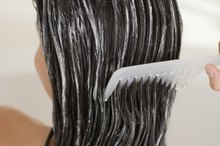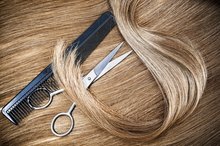What Are the Causes of Oily Hair After One Day?
Oily hair feels unpleasantly sticky, like it has a greasy film on it. Thick-strand and kinky hair may be capable of bearing up under the weight of excess oil. Hair that is thin and straight, however, is limp and difficult to style when it is oily. If your hair becomes oily even the day after washing it, a few changes to your hair-care routine can help.
Oily Scalp
Your scalp has sebaceous, or oil, glands that produce oil or sebum to moisturize and protect your hair naturally. When these oil glands are overactive, they produce too much oil for your hair, says Pamela Ferrell, author of "Let's Talk Hair." When oil builds up quickly on your scalp, you’re also likely to suffer from dandruff or seborrheic dermatitis 12. Apply an over-the-counter or medicated shampoo specifically for oily scalp or seborrheic dermatitis -- for instance, one that contains zinc pyrithione -- to help to control oiliness on your scalp and in your hair.
- Your scalp has sebaceous, or oil, glands that produce oil or sebum to moisturize and protect your hair naturally.
- Apply an over-the-counter or medicated shampoo specifically for oily scalp or seborrheic dermatitis -- for instance, one that contains zinc pyrithione -- to help to control oiliness on your scalp and in your hair.
Hair Products
Harmful Effects of Conditioner
Learn More
Heavy greases or creams can leave your hair oily and limp the next day. Some pomades or greases -- for instance, Sulfur8 -- are used to control scalp conditions such as itchiness and dandruff, so you may be reluctant to limit your use of them. Try a lighter formula of these products or liquid oils, which may result in less oiliness. Wash your hair regularly with the right shampoo for your scalp condition, and you should be able to rely less on heavy, medicated greases. Also, limit your use of oily-styling sprays, gels or foams.
- Heavy greases or creams can leave your hair oily and limp the next day.
- Some pomades or greases -- for instance, Sulfur8 -- are used to control scalp conditions such as itchiness and dandruff, so you may be reluctant to limit your use of them.
Shampooing Frequency
When you have oily hair, wash it often enough to remove oily buildup in your hair. Focus on cleansing your scalp rather than scrubbing and washing your hair, says Anthony Dickey, a stylist based in New York City and author of “Hair Rules!” A simple way to do this is to let your fingers -- rather than the palms of your hands -- do the work 3. Shampoo often enough to control oily buildup, but not so frequently that you send the oil glands into overdrive, Dickey says. Experiment with schedules to find the one that works best for you.
- When you have oily hair, wash it often enough to remove oily buildup in your hair.
- Shampoo often enough to control oily buildup, but not so frequently that you send the oil glands into overdrive, Dickey says.
Cream Rinses
What Causes Oily Hair?
Learn More
Applying a cream rinse or conditioner after shampooing makes hair smooth and supple. Frequent conditioning, however, can cause residues to build up on your hair, leaving it oily and limp. For oily hair, use these products as seldom as possible, and follow the instructions for application, rinsing and frequency of use, says Ferrell.
Related Articles
References
- “Let’s Talk Hair”; Pamela Ferrell; 1996
- American Academy of Dermatology: Seborrheic Dermatitis
- “Hair Rules”; A. Dickey; 2003
- Baker LB. Physiology of sweat gland function: The roles of sweating and sweat composition in human health. Temperature (Austin). 2019;6(3):211-259. doi:10.1080/23328940.2019.1632145
- Zielińska A, Nowak I. Abundance of active ingredients in sea-buckthorn oil. Lipids Health Dis. 2017;16(1):95. doi:10.1186/s12944-017-0469-7
- Phillips TG, Slomiany WP, Allison R. Hair Loss: Common Causes and Treatment. Am Fam Physician. 2017;96(6):371-378.
- Watras MM, Patel JP, Arya R. Traditional anticoagulants and hair loss: a role for direct oral anticoagulants? A review of the literature. Drugs Real World Outcomes. 2016;3(1):1-6. doi:10.1007/s40801-015-0056-z
- Urysiak-czubatka I, Kmieć ML, Broniarczyk-dyła G. Assessment of the usefulness of dihydrotestosterone in the diagnostics of patients with androgenetic alopecia. Postepy Dermatol Alergol. 2014;31(4):207-15. doi:10.5114/pdia.2014.40925
- Vincent M, Yogiraj K. A descriptive study of alopecia patterns and their relation to thyroid dysfunction. Int J Trichology. 2013;5(1):57-60. doi:10.4103/0974-7753.114701
- Peters EMJ, Müller Y, Snaga W, et al. Hair and stress: A pilot study of hair and cytokine balance alteration in healthy young women under major exam stress. PLoS ONE. 2017;12(4):e0175904. doi:10.1371/journal.pone.0175904
- Pratt CH, King LE, Messenger AG, Christiano AM, Sundberg JP. Alopecia areata. Nat Rev Dis Primers. 2017;3:17011. doi:10.1038/nrdp.2017.11
- American Academy of Dermatology. Alopecia Areata: Overview.
Writer Bio
Kay Uzoma has been writing professionally since 1999. Her work has appeared in "Reader’s Digest," "Balance," pharmaceutical and natural health newsletters and on websites such as QualityHealth.com. She is a former editor for a national Canadian magazine and holds a Bachelor of Arts in political science from York University.








